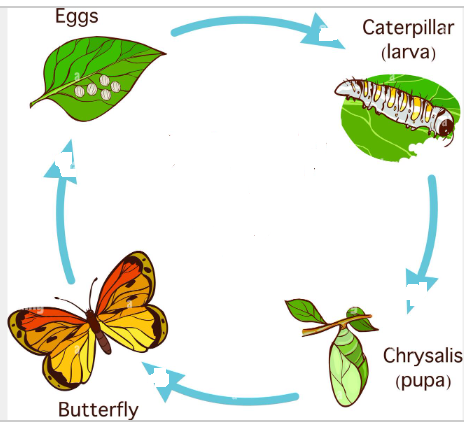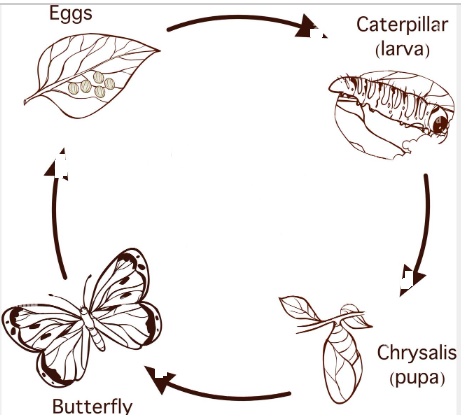Life Process of a Butterfly (Citrous swallowtail butterfly)

Life Process of a Butterfly (Citrous swallowtail butterfly)
Biological classification
-
- Phylum Arthropoda.
Reasons:
- Undergo moulting or ecdysis.
- They are haemocilic (have open circulation).
- Bilaterally symmetrical.
- Possess metameric segmentation.
- Butterfly have a chitinous exoskeleton.
- Presence of jointed appendages attached to each segment.
- They are also triploblastic coelomate.
-
Class Insecta:
-
Reason:
- Possess a pair of compound eyes.
- Body is divided into three (head, thorax and abdomen).
- They also possess a pair of antennae (feelers).
- Presence of three pairs of thoracic legs.
- Also possess two pairs of wings.
-
Order Lepidoptera:
-
Reason;
- Mouthparts modified as coiled proboscis for sucking.
- Wings and body are covered with scales.
- They also exhibit complete metamorphosis.
The Body Structure of a Butterfly.

The body structure of a butterfly is divided into three;
- the head,
- the thorax,
- and the abdomen.
The Head:
- The head bears a pair of compound eyes.
- A pair of antennae which is club-shaped is found on the head.
- The head also has a mandible, labium and labrum (mouthparts).
- A pair of maxillae is modified into a long, hollow, flexible, coiled tube called a proboscis.

The Thorax:
- The thorax is divided into three segments. (Prothorax, Mesothorax and Metathorax).
- Each segment bears a pair of jointed legs.
- The mesothorax and mesothorax bear a large membranous wing which is covered with scales.
- Each hind wing has two eye spots for protection against predation.
The abdomen:
- The abdomen is made up of segments.
- The segments are covered with hairs.
Life cycle.
Butterfly goes through a complete metamorphosis in its life cycle. (Eggs, larva (caterpillar), pupa and imago)
The male and female butterflies are attracted to each other by the colour patterns and chemicals.
The male then deposits sperm into the genitalia of the female.
The eggs are fertilized internally.
The eggs are laid on the under-surface leaves after which each egg hatches into a larva called a caterpillar.
The Larva Stage of The Life Cycle of Butterfly (The Caterpillar)
- It has a head, thorax and abdomen
- It has a small head which bears the mouthparts for chewing.
- Has no compound eyes but six ocelli
- A pair of short antennae
- It also has nine pair of spiracles, one pair on the prothorax, and eight pairs on the first eight abdominal segments.
- The thorax bears three pairs of walking legs
- The 3d, 4h, 5h and 6″ abdominal segments bear cushion feet called prolegs
- The tenth abdominal segment is modified into a pair of claspers
- The functions of the legs, prolegs and claspers are for walking and holding firmly to the plant.
- Has a structure called the osmeterium.
- Osmeterium has a foul smell which provides defense.
- Pairs of spiracles on the thorax and abdomen for gaseous exchange.
- It feeds actively and grows actively and also moults several times.
- The caterpillar stops feeding and produces a silk pad called the cremaster on the plant
- Silk girdle (cocoon) around its thorax.
- After this, the caterpillar larva moults the last time and changes to a pupa called a chrysalis
- The silk girdle (cocoon) protects the larva against drying up and predators
The Pupa (Chrysalis)
- It possesses brown and green colours, making it camouflage, thereby protecting itself from enemies.
- At the pupal stage the body parts such as compound eyes, antennae, wings, proboscis and reproductive organs are formed.
- At the end of the pupal stage the pupa case splits open and the young adult climbs out and rests for 2 hours for its wings to expand and harden before flying away.

Economic importance of butterfly
(The larva and adult are both pests of citrus)
- The larva destroys citrus leaves
- The adult destroys citrus fruits
- The adult also pollinates flowers
- Some caterpillars produce silk
- Used as ornaments
Explain how butterfly affects crop production.
Butterflies affect crops as pollinators and pests.
- As pollinators,
when they visit a flower to suck nectar with its proboscis
Pollen grains adhere to the underside of the insect.
As it visits another flower in other to obtain more nectar,
Pollen from its body gets dusted on the stigma of the flower thereby bringing about pollination,
And increasing crop yield and fruit production
- As a pest,
They feed on fruits using their proboscis to pierce the fruit to suck the juice.
This leads to the destruction of the fruit and brings loss to the farmer.
State similarities between imago and caterpillar.
- Presence eyes
- Both possess eyes spot.
- Three pairs of thoracic legs.
- Three body divisions.
- Spiracles
- Possession of segmented body.
State the adaptive features of a caterpillar to escape danger.
- Possess colour which provides camouflage and blends with the leaves.
- Osmeterium produces a foul smell temporally to scare predators.
- Presence of eyes spot frightens predators.
Importance of caterpillar in agriculture.
- They feed on the leave of plants (crops).
- Caterpillar pierces and sucks citrus fruits causing premature fruit fall and reducing yield.
- They also pollinate the flowers of crops leading to fertilization and fruit formation.
Revision Questions.
- State five observable features of the butterfly.
- List five observable features of the caterpillar.
- Give five economic importance of the butterfly.
- State four differences between a caterpillar and a butterfly.
- State three differences and similarities between moth and butterfly.
Join Enlighten Knowledge WhatsApp Channel.
Join Enlighten Knowledge Telegram platform.





